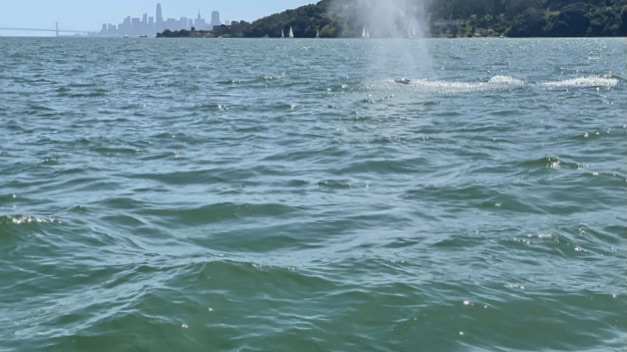
Biden Administration Protects Endangered Pacific Humpback Whales’ Habitat
Spotting a flock of wild turkeys crossing a road or seeing a bald eagle fly overhead in Marin is still a source of wonder, but as sightings increase the thrill does subside. Could it soon be the same with humpback whales? It’s hard to imagine because we still leap to catch a glimpse of any whale that surfaces, even as whale sightings become increasingly common. Readers are sending in more great photos and videos, and we seem to spot whales almost every time we head out.
It’s wonderful to have them back, and as we approach Earth Day on April 22 and World Oceans Day on June 8, we have more good news for whales, and sailors who share their ocean. We received the following story from Turtle Island Restoration Network in Olema, CA:
Biden Administration Protects Endangered Pacific Humpback Whale Habitat
Final Rule Designates 116,098 Square Nautical Miles as Critical Habitat
SAN FRANCISCO—The Biden administration issued a final rule today protecting 116,098 square nautical miles of the Pacific Ocean as critical habitat for three populations of endangered humpback whales. The rule could begin to help protect migrating whales from ship strikes, entanglement in fishing gear, and oil spills.

The action was prompted by a 2018 legal victory by the Center for Biological Diversity, Wishtoyo Foundation and Turtle Island Restoration Network. The groups had sued over the federal failure to designate critical habitat as required by the Endangered Species Act. The suit led the Trump administration to issue a proposed rule in 2019 and today’s final rule.
“Today is a good day for humpback whales and the ocean all living things depend on,” said Todd Steiner, executive director of Turtle Island Restoration Network. “Designating 116,000 square miles of critical habitat in the ocean is something to celebrate, but whales, turtles and dolphins still need additional protection from industrial fishing and ship strikes to recover and thrive, so we won’t be resting on our laurels.”
The biggest threats in humpback habitat are ships and fishing gear. The Center sued the federal government in January for failing to protect endangered whales from speeding ships using California ports. The organization is also co-sponsoring the California Whale Entanglement Prevention Act (Assembly Bill 534), which would require the state’s commercial Dungeness crab and other trap fisheries to convert to ropeless gear (also known as “on-demand” or “pop-up buoy” gear) by the end of 2025.
One population of endangered humpback whales that feeds off California’s coast contains fewer than 800 individuals, leaving them vulnerable to threats from humans. Today’s rule designates a total of 224,030 square nautical miles for the two endangered and one threatened populations, but overlapping habitat means 116,098 square nautical miles will be protected.
The rule designates 48,521 square nautical miles of critical habitat off the coast of California, Oregon and Washington for the humpback population that winters in Central America. The Mexico population got 116,098 square nautical miles in the North Pacific Ocean, including Bering Sea and Gulf of Alaska — regions that also made up the 59,411 square nautical miles listed for the Western North Pacific humpback population.
Randall von Wedel captured a whale surfacing a couple weeks ago off Point Conception.
“Pacific humpbacks finally got the habitat protections they’ve needed for so long. Now we need to better protect humpbacks from ship strikes and entanglement in fishing gear, their leading causes of death,” said Catherine Kilduff, an attorney with the Center. “To recover West Coast populations of these playful, majestic whales, we need mandatory ship speed limits and conversion of California’s deadly trap fisheries to ropeless gear.”
Critical habitat protection will help safeguard ocean areas essential for migrating and feeding. The designation will ensure that federally permitted activities do not destroy or harm important whale habitat. Evidence shows that endangered or threatened species that have protected critical habitat are twice as likely to be recovering as those without it. – END
Latitude 38 plans to celebrate the June 8 World Oceans Day during the entire month of June. We will be looking to highlight sailors, as in our recent story on Scott Chowning, and sailing organizations like Save Ocean Wildlife, featured in the April issue, who are helping restore ocean health. We want to hear more from sailors who are leading the way to more sustainable oceans. If you have suggestions, email us here.

Thanks for the news update. Perhaps in future articles you could provide some additional links to other sources of information. The SF Chronicle article has a useful map: https://www.sfchronicle.com/local/environment/article/Endangered-humpback-whales-get-extra-habitat-16115817.php
They also provide some additional interpretation on what the rule is beyond the designated area:
“The new rule does not prevent commercial fishing within the critical habitat, but it does require any project planned or permitted by the federal government within the boundaries does not destroy the whales’ habitat or keep them from their feeding grounds. It requires the Coast Guard to consult with the National Marine Fisheries Service when deciding on the location of shipping lanes, such as those in and out of San Francisco Bay, to make sure they don’t cross whale feeding areas.” SFChronicle.
Details can be found on the NOAA website:
https://www.fisheries.noaa.gov/action/final-rule-designate-critical-habitat-central-america-mexico-and-western-north-pacific
It looks like the Biden Administration is being praised for something the Trump Administration began. BTW, I didn’t vote for either one. The headline should have sidestepped any Administration praise and focused on the groups that pushed them.
There’s no doubt that many activists and organizations should get the credit for making this happen. Current administrations often get the credit or blame for things that they did not initiate. Maybe we should just be thankful they didn’t obstruct progress and we could have used a different headline to give more credit to those who did the work.